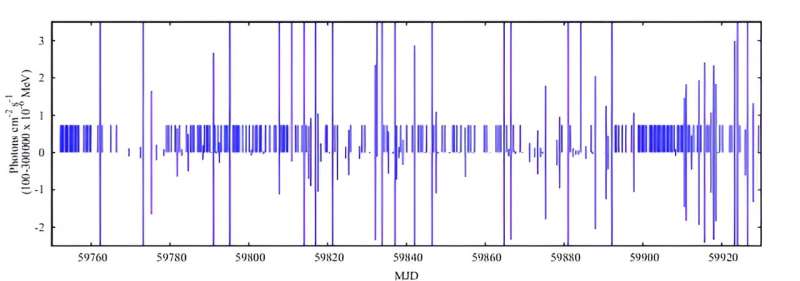November 24, 2023 report
This article has been reviewed according to Science X's editorial process and policies. Editors have highlighted the following attributes while ensuring the content's credibility:
fact-checked
preprint
trusted source
proofread
Data from Fermi Gamma-ray Space Telescope reveal gamma radiation pulses from Sagittarius A*

A pair of astrophysicists at Universidad Nacional Autonoma de Mexico has found, via study of data from the low-Earth orbiting Fermi Gamma-ray Space Telescope, regular gamma radiation pulses emanating from around the black hole (at the center of the Milky Way galaxy Sagittarius A*). Gustavo Magallanes-Guijón and Sergio Mendoza have written a paper describing their findings, published on the arXiv preprint server.
Prior research has shown that there is a relatively stable supermassive black hole near the center of the Milky Way galaxy—it has been named Sagittarius A*. Prior research has also shown that, unlike many other supermassive black holes at the center of other galaxies, Sagittarius A* is not actively pulling in hordes of materials, nor is it shooting out a lot of jets of plasma.
In this new effort, the research pair has found something else unique about it, though: A blob of gas orbiting it at a distance similar to that of Mercury from the sun.
Back in 2021, scientists were able to identify gamma radiation arriving here on Earth as coming from Sagittarius A*. Scientists have known since that time that such radiation is not coming from the black hole itself—black holes do not emit radiation—but from something close to it. In this new effort, the researchers sought to learn more about the source of such radiation.
The work by the researchers involved obtaining publicly available data captured by the Fermi Gamma-ray Space Telescope for the period June to December 2022 and then analyzing it. Their analysis involved processing and searching for patterns, particularly those that occurred periodically. In so doing, they found one.
They discovered that every 76.32 minutes, a pulse of gamma radiation emitted from something close to Sagittarius A* makes its way to Earth. Such pulses, they note, have a periodicity of almost exactly half of the X-ray flares that have been recorded also coming from near Sagittarius A*, suggesting that the two are connected.
The research pair suggests that the source of both is likely a blob of gas orbiting Sagittarius A*—one that is traveling at nearly 30% of the speed of light. They also suggest that the blob is emitting across multiple wavelengths and flares periodically as it moves.
More information: Gustavo Magallanes-Guijón et al, A 76 minute gamma-ray periodicity in Sagittarius A*, arXiv (2023). DOI: 10.48550/arxiv.2311.05875
Journal information: arXiv
© 2023 Science X Network



















